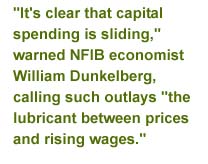|
Main Street still solid
|
 |
October 16, 2000: 9:11 a.m. ET
Small business remains strong in survey, but key spending is slipping
|
NEW YORK (CNNfn) - Gyrations in the stock market are unlikely to do any harm to the economy, but a developing slowdown in capital spending threatens inflation-free growth, a small-business economist warned Monday.
So far, that threat seems remote. The Main Street economy slipped only a fraction in September, easing 8/10ths of a point to 101.1, according to the "Index of Small Business Optimism" as compiled by the National Federation of Independent Business.
"This is a very solid economy without much slowing in the fourth quarter, as many have predicted," said William C. Dunkelberg, the NFIB's chief economist.
 In several key measures, the market remains near its peaks. Workers remain hard to find, with 32 percent of employers reporting they had jobs they could not fill, just shy of the record 35-percent rate set in August. In several key measures, the market remains near its peaks. Workers remain hard to find, with 32 percent of employers reporting they had jobs they could not fill, just shy of the record 35-percent rate set in August.
Still, 18 percent of employers in the survey planned to add staff (net of those planning reductions), down 2 percentage points from August but just 4 points below the measure's all-time peak.
Thirty-two percent reported rising labor compensation, but only 7 percent cited labor costs as their No. 1 business concern.
A net 13 percent of the 1,200 companies in the survey reported raising their prices, up three points from August but 6 points below the 19 percent who raised prices in June, the peak for the year.
Weakening trend in capital spending
Capital spending plans climbed 4 points to 32 percent of all firms, but on a year-to-date basis, planned outlays are still the weakest in four years. Meanwhile, reports of actual spending in the past six months declined in September for a third consecutive month, pointing to reduced business investment by small companies.
The NFIB found similar patterns of declining investment plans in the months prior to the last two recessions, in the early 1980s and the early 1990s.
"It's clear that capital spending is sliding," Dunkelberg said. Such a trend is worrisome in a strong economy, he said, because productivity-enhancing equipment purchases represent "the lubricant between prices and rising wages."
If companies can no longer make their employees more efficient by improving their tools, then rising wages in a tight labor market will lead to higher unit costs and increasing inflation, he warned. And that raises the threat of higher interest rates by the Federal Reserve Board, "because we worry about what the Fed will do."
On the other hand, Dunkelberg shrugged off the volatility in the stock market as irrelevant to the Main Street economy. The Nasdaq plummeted last week by 72.05 points, or 2.2 percent, on Wednesday and by 93.81, or 3 percent, on Thursday, before rocketing on Friday by 242.09 points, or 7.87 percent, its second-best point gain on record, to end the week at 3,316.77.
In 1987, the year of a historic market crash, "it didn't do anything," Dunkelberg recalled. In his monthly survey of 1,200 companies then, "there was no difference. They were still hiring. Capital spending was still going on." 
|
|
|
|
|
 |

|

